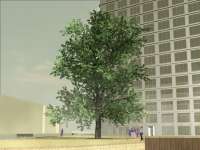Revolution Tree consists of the siting of a large mature Oak tree, where its rootball is planted in a purpose built container that is extremely slowly continuously revolving. The container and all mechanics are hidden underground and the work is completely silent. The viewer sees a large mature tree, which due to its scale, appears to have grown there over many years. As they look a little closer, they perceive that the tree is exceedingly slowly, continuously turning. The perception of this motion would be almost imperceptible but once detected unmissable. Revolution comes from a Sanskrit root that means to discover, open but also to turn or return. It refers to a far-reaching change in the way something works or in people’s ideas about it. It also has an astronomical meaning, the eternal return, referring to the revolution of the planets around the Sun, for example or the Earth’s motion on its own axis. Julia Kristeva extends the definition of revolution beyond politics per se and sees revolt as a state of permanent questioning and transformation, of a change that characterises psychic life. A tree that continuously revolves, defies any sense of an establishing order and opens up a state of questioning in the surrounding environment. One looks again at the world around us; Revolution Tree embodies in our memory a form of permanent doubting. Straddling the line between reality and unreality, the uncanny or fantastical derives from something strangely familiar which defeats our efforts to separate ourselves from it. “The fantastic, we have seen, lasts only as long as a certain hesitation: a hesitation common to reader and character, who must decide whether or not what they perceive derives from "reality" as it exists in the common opinion. At the story's end, the reader makes a decision even if the character does not; he opts for one solution or the other, and thereby emerges from the fantastic. If he decides that the laws of reality remain intact and permit an explanation of the phenomena described, we say that the work belongs to another genre: the uncanny. If, on the contrary, he decides that new laws of nature must be entertained to account for the phenomena, we enter the genre of the marvelous.”1 The tree proposed for the project is a Pin Oak from the Red Oak group. The Pin Oak or Quercus Palustrus means "of marshes". It is naturally a wetland tree, and would have proliferated at one time at the mouth of rivers, in harbour areas. The Oak is also the tree most commonly used for ship-building, from the Middle ages to the last built wooden ships. The Pin Oak or Quercus Palustrus is particularly suited for this project because of its hardiness and ability to successfully withstand transplanting and also for its remarkable autumn foliage. 1 The uncanny, a mode of fantastic fiction as defined in Tzvetan Todorov's The Fantastic: A Structural Approach to a Literary Genre.
Revolution Tree consists of the siting of a large mature Oak tree, where its rootball is planted in a purpose built container that is extremely slowly continuously revolving. The container and all mechanics are hidden underground and the work is completely silent. The viewer sees a large mature tree, which due to its scale, appears to have grown there over many years. As they look a little closer, they perceive that the tree is exceedingly slowly, continuously turning. The perception of this motion would be almost imperceptible but once detected unmissable. Revolution comes from a Sanskrit root that means to discover, open but also to turn or return. It refers to a far-reaching change in the way something works or in people’s ideas about it. It also has an astronomical meaning, the eternal return, referring to the revolution of the planets around the Sun, for example or the Earth’s motion on its own axis. Julia Kristeva extends the definition of revolution beyond politics per se and sees revolt as a state of permanent questioning and transformation, of a change that characterises psychic life. A tree that continuously revolves, defies any sense of an establishing order and opens up a state of questioning in the surrounding environment. One looks again at the world around us; Revolution Tree embodies in our memory a form of permanent doubting. Straddling the line between reality and unreality, the uncanny or fantastical derives from something strangely familiar which defeats our efforts to separate ourselves from it. “The fantastic, we have seen, lasts only as long as a certain hesitation: a hesitation common to reader and character, who must decide whether or not what they perceive derives from "reality" as it exists in the common opinion. At the story's end, the reader makes a decision even if the character does not; he opts for one solution or the other, and thereby emerges from the fantastic. If he decides that the laws of reality remain intact and permit an explanation of the phenomena described, we say that the work belongs to another genre: the uncanny. If, on the contrary, he decides that new laws of nature must be entertained to account for the phenomena, we enter the genre of the marvelous.”1 The tree proposed for the project is a Pin Oak from the Red Oak group. The Pin Oak or Quercus Palustrus means "of marshes". It is naturally a wetland tree, and would have proliferated at one time at the mouth of rivers, in harbour areas. The Oak is also the tree most commonly used for ship-building, from the Middle ages to the last built wooden ships. The Pin Oak or Quercus Palustrus is particularly suited for this project because of its hardiness and ability to successfully withstand transplanting and also for its remarkable autumn foliage. 1 The uncanny, a mode of fantastic fiction as defined in Tzvetan Todorov's The Fantastic: A Structural Approach to a Literary Genre.

